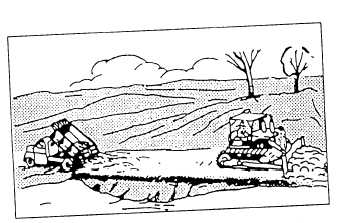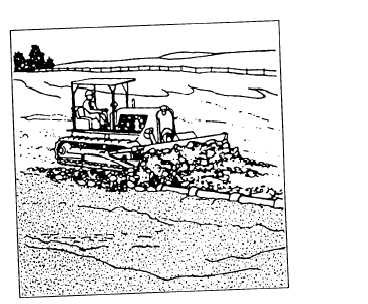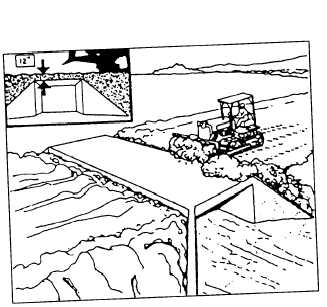Figure 11-28.-Spreading.
Figure 11-29.–Culvert backfilling.
SPREADING.— Dozers are ideal for spreading fill
material brought in by haul units (fig, 11-28). Position
the blade in a straight position, so the material is drifted
directly under the cutting edge.
BACKFILLING.— Backfilling is the process of
replacing excavated earth, as shown in figure 11-29.
When a culvert is backfilled, the dozer should not cross
the culvert unless there is at least 12 inches of compacted
material on top of the culvert. If a bulldozer is used to
bacfill a culvert, the best method is to make diagonal
passes over the material, ending each pass with a swing
that brings the blade in line with the culvert.
The angle blade is preferred for bacfilling a
trench, because material can be side cast into the trench
while maintaining a steady forward motion, as shown in
figure 11-30.
Figure 11-30.Trench backfilling.
When a pipe trench is bacfilled, fine material is
placed around the pipe and coarse material above it, so
the pipe is supported by well-compacted material.
However, covering the pipe to full depth in short lengths
may concentrate weight and break pipe joints; therefore,
cover the pipe in successive layers, rather than all at
once.
NOTE: Be careful in pipe trench bacfilling to
avoid dropping large rocks directly on the pipe.
FINISHING.— Whether clearing or spreading
material on a roadbed, no job is completed until it has
been smoothed and drainage is established. This is
called finishing and should be done at the end of each
Shift.
Blade the job lightly with about a half of a blade of
dirt. This fills in any low spots or holes. Leave a
windrow on the side that you are working toward. At the
start of the next pass, cover half the blade width.
Continue in this fashion over the project or section of
the project you have worked that day before you shut
down for the day. Finishing the project in this manner
supports drainage and prevents having to walk over
piles of dirt or through mudholes.
Ditching
Rough ditching can be done with a dozer by making
a series of overlapping passes at right angles to the line
of the ditch. A “V” type of ditch can be dug with a dozer
as follows: First, buildup a windrow along the edge of
11-15







